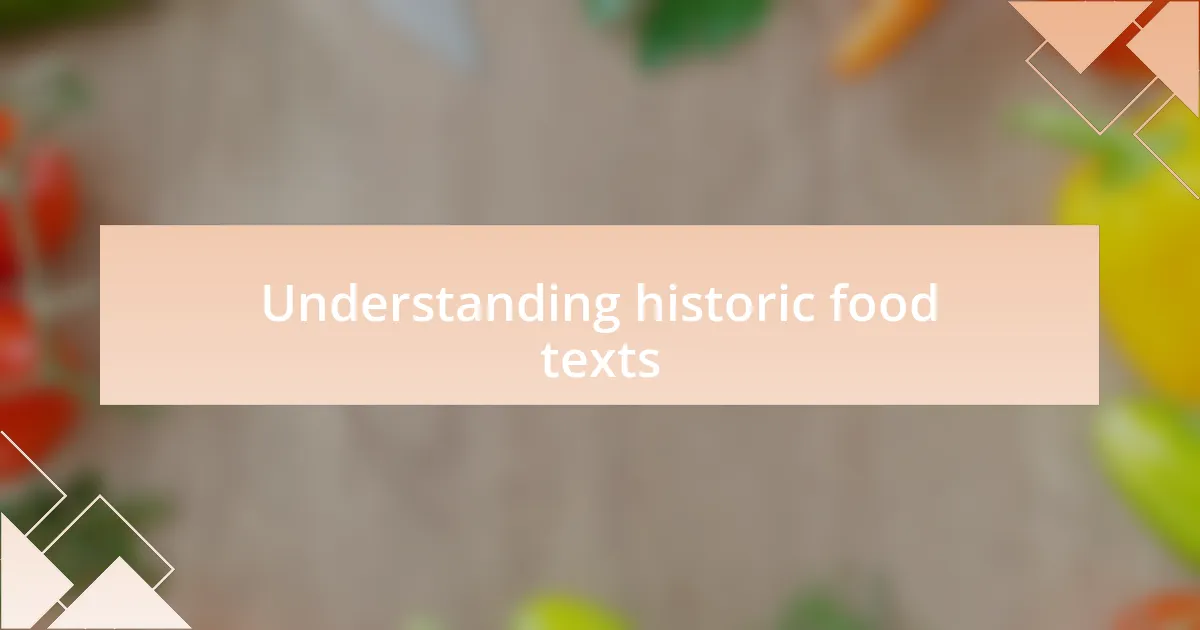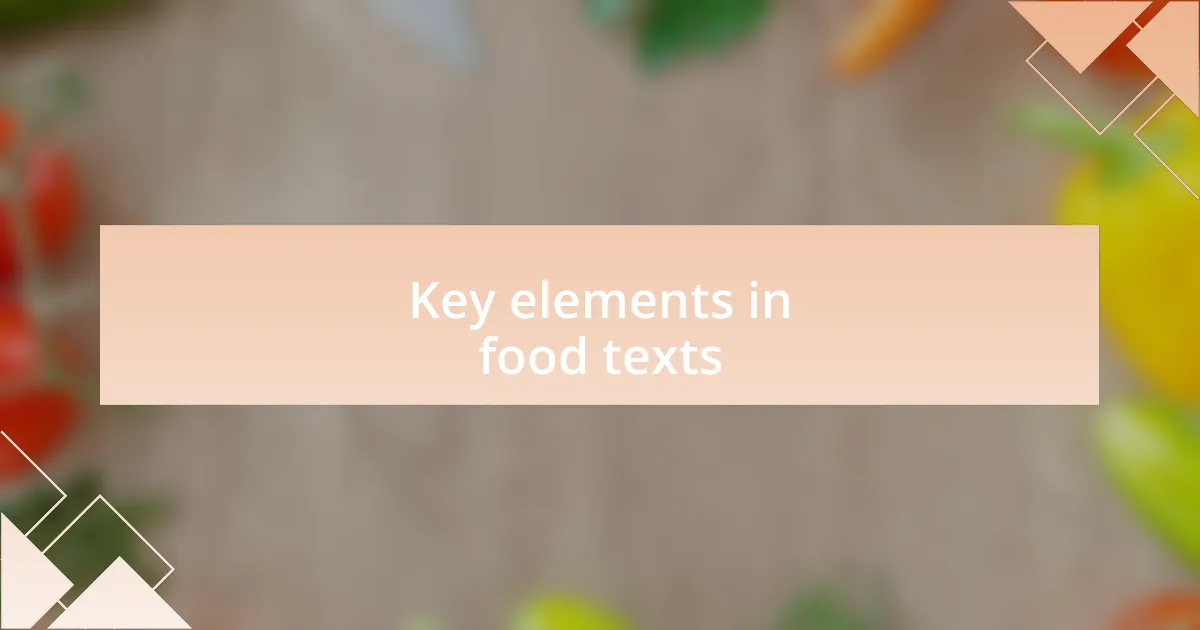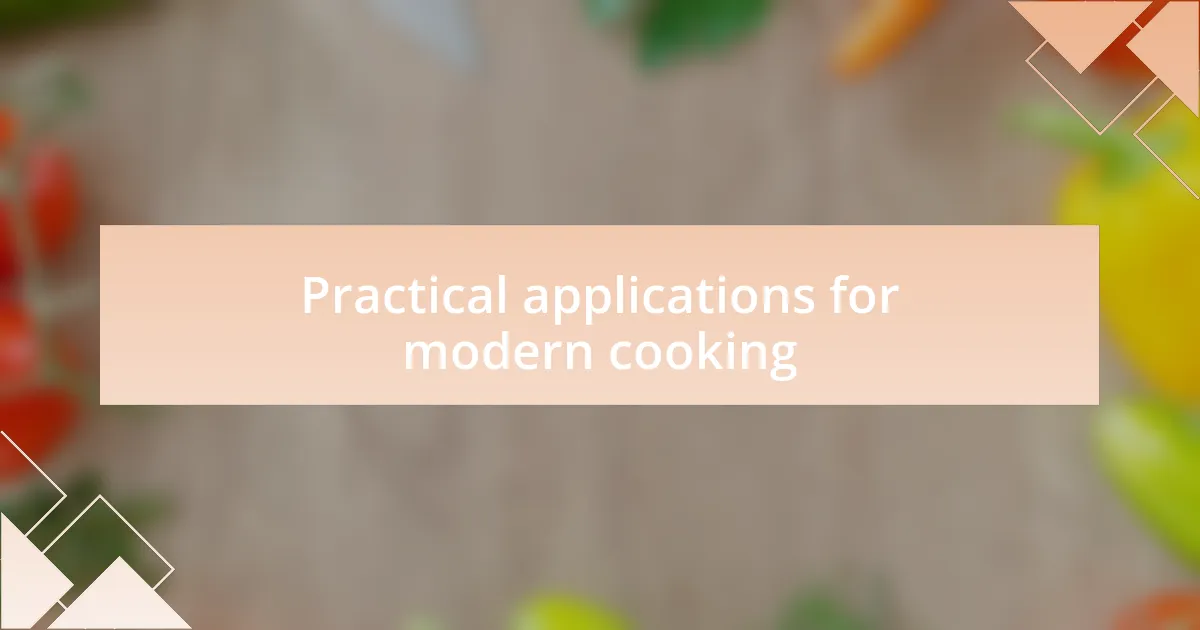Key takeaways:
- Historic food texts connect us to past culinary practices and societal dynamics, enriching our understanding of contemporary cooking.
- Culinary education fosters innovation and creativity while grounding us in traditional methods, enhancing the collaborative cooking experience.
- Techniques like preservation and use of seasonal ingredients reflect resourcefulness and cultural heritage, offering insights for modern cooks.
- Recreating traditional recipes serves as a medium for storytelling, emphasizing the connection between food, culture, and community across generations.

Understanding historic food texts
Understanding historic food texts reveals a treasure trove of cultural insights and culinary practices that shaped the way we eat today. I remember the first time I pored over an ancient cookbook—it was as if I was transported back in time, connecting with the people who crafted these recipes. What was their reality? How did they gather ingredients and prepare their meals? Each text not only lists ingredients but often reflects the social dynamics of its time.
When examining these texts, I often find myself captivated by the language and nuances that aren’t always clear at first glance. I recall trying to decipher a medieval recipe, complete with terms and techniques that felt foreign. It was a frustrating yet exhilarating experience. I wondered, how many cooks struggled with the same challenges in the past? This connection across centuries enriches my understanding of cooking as a shared human experience.
Moreover, historic food texts serve as a mirror, reflecting the evolving tastes and dietary practices of different eras. I’ve often felt a thrill when I discover how certain flavors were celebrated or how preservation methods varied from culture to culture. It makes you ponder: what does today’s culinary landscape say about us? By diving into these texts, we’re not just learning to cook but understanding the stories and histories that flavor our plates.

Importance of culinary education
Culinary education is crucial because it provides the foundation for understanding the rich tapestry of food culture. I’ll never forget my first culinary class, where I was introduced to traditional techniques that had been passed down through generations. It struck me how learning these methods gave me a deep appreciation for the food I prepare, connecting me to a legacy much larger than myself.
As I delved deeper into culinary studies, I realized how education empowers us to innovate while respecting tradition. I remember working on a project that required me to reimagine a classic dish. The process made me appreciate the delicate balance between honoring its origins and adding a personal twist. Isn’t it fascinating how education can kindle creativity while anchoring us to our culinary roots?
Moreover, culinary education fosters a sense of community and collaboration. In one memorable group project, we were tasked with developing a menu drawing inspiration from historical food texts. Sharing ideas and learning from my peers transformed the experience into a vibrant exchange of knowledge. How often do we get a chance to create something meaningful together while immersing ourselves in culinary history? This collaborative spirit is not just about cooking; it’s about building connections that enrich our culinary journey.

Key elements in food texts
When I examine historic food texts, several key elements stand out to me. The recipes themselves are essential, but it’s the context surrounding them that truly captivates. For instance, one charming recipe I found from an ancient cookbook revealed intriguing ingredient substitutions based on what’s available in a region. It prompted me to think about how our contemporary ingredients connect to those of the past. Isn’t it incredible to consider how resourcefulness defines our culinary practices through time?
Another key element is the use of language and description. I recall poring over a manuscript filled with elaborate descriptions of flavors and textures. The way ingredients were beautifully articulated transported me into a sensory experience, almost as if I could taste the dishes while reading. This made me wonder: how does the language we use today mirror or diverge from the past? Exploring these nuances enhances our relationship with food, linking us to the emotional stories behind each recipe.
Moreover, historic food texts often reflect social and cultural narratives that shape culinary practices. I was struck by a document discussing communal feasts and the roles people played in these events. It made me reflect on my own experiences of gathering with friends and family over shared meals. How do our modern culinary practices replicate these historical traditions? This awareness deepens my understanding of food not just as sustenance, but as a medium for storytelling and connection across generations.

Techniques in historic recipes
When exploring historic recipes, I often find that techniques tell just as much of a story as the ingredients themselves. For instance, I came across an old collection of pickling techniques that intrigued me; the layering of flavors and the balance of acid demonstrated a methodical approach reminiscent of today’s culinary precision. What’s fascinating is how these techniques have endured through generations, evolving yet remaining true to their roots.
Diving into bread-making techniques from centuries past has been particularly enlightening for me. The use of natural leavening agents, like sourdough starters, evokes a sense of connection to artisans who relied on their intuition and environment. I sometimes wonder if this reliance on natural elements today could bring us closer to our own food heritage. Have you ever tried recreating a recipe using these age-old methods? It’s a fulfilling experience that bridges the gap between the past and our present kitchens.
As I sift through historic cooking methods, it’s the preservation techniques that resonate deeply with me. I remember attempting to make my own jams using the techniques from a Victorian cookbook; the patience required in boiling fruits and preserving them in jars felt like a meditative process. It raised questions for me about sustainability and the importance of preserving not just food, but culinary traditions themselves. Could these age-old techniques offer insights into reducing waste and connecting us with the cycles of nature around us?

Lessons learned from traditional dishes
Traditional dishes have a unique way of teaching us about cultural values and social connections. I remember the first time I experienced a family recipe for stuffed grape leaves. It wasn’t merely about the dish itself, but the process of gathering together, the conversations, and the shared laughter that brought the meal to life. Isn’t it fascinating how food can become a vehicle for storytelling and bonding across generations?
One lesson I’ve learned through traditional cooking is the importance of seasonal ingredients. I once tried my hand at a winter stew based on an age-old recipe, using whatever vegetables were available in my pantry. The result was a hearty dish that embraced the essence of the season while reminding me of how our ancestors adapted to their surroundings. Have you ever noticed how traditional recipes often reflect the rhythm of nature? It’s a reminder that food isn’t just nourishment; it’s about honoring the land and its cycles.
Additionally, traditional dishes offer a glimpse into the past, revealing techniques and flavors that can deepen our culinary repertoire. When I replicated my grandmother’s pasta recipe, the act of kneading the dough by hand felt almost ritualistic. It was a connection to her and the generations before her, learning that cooking is as much about technique as it is about heritage. I believe these meals carry stories worth preserving, don’t you? They keep our culinary history alive, allowing us to learn and grow in the kitchen today.

Personal reflections on food texts
Reflecting on food texts has always been a journey of rediscovery for me. I recall diving into an old cookbook that belonged to my aunt, which contained handwritten notes in the margins. Her notations transformed the pages into a time capsule, containing not just recipes but glimpses into her thoughts and experiences. Doesn’t it evoke a bittersweet nostalgia to see someone’s handwritten notes peppered with personal stories and memories that intertwine with the recipes?
Reading historical food texts has also reshaped my understanding of cuisine as a living narrative. I once stumbled upon a collection of medieval recipes, and the intricate instructions transported me to a time when every meal was an event, intertwined with rituals and societal norms. It made me ponder—how much have we lost in our fast-paced cooking culture? There’s something beautifully complex about recipes that challenge us to slow down and engage with the roots of our culinary practice.
Moreover, the way food texts capture the essence of an era fascinates me. I remember recreating a dish inspired by an ancient Roman recipe and was surprised by how it challenged my palate. The bold spices and unconventional combinations felt like stepping into a history lesson. I often wonder, how can we blend those traditional flavors into our modern kitchens while respecting their origins? This ongoing interplay between past and present gives me excitement, urging me to explore and reinterpret the stories behind each recipe.

Practical applications for modern cooking
When I first tried incorporating recipes from historic food texts into my own cooking, it felt like embarking on an adventure. One instance stands out: I attempted a classic French dish called coq au vin, inspired by a 19th-century recipe. The process was labor-intensive, but it forced me to appreciate each ingredient’s role and the patience required in cooking—a stark contrast to my usual weeknight dinners. Do modern cooks often overlook the value of slow food in favor of quick fixes?
Delving into the world of historic cooking taught me the importance of seasoning and flavor layering, reminiscent of how earlier cooks relied on fresh, seasonal ingredients. In one experiment, I decided to use authentic spices from a long-forgotten Persian text. The aroma that filled my kitchen was captivating and sparked a sense of creativity within me to blend the old with the new. Isn’t it thrilling to elevate contemporary dishes by incorporating ancient techniques?
Another practical application I’ve embraced is the concept of meal preparation and preservation methods from the past, like pickling and fermentation. Recently, I preserved vegetables using a century-old technique, which not only added new flavors to my dishes but also connected me to the generations who practiced these methods to combat seasonal shortages. Why not join in on this tradition and create something vibrant and alive in your kitchen? Each jar reflects a piece of history, inviting a dialogue between old culinary practices and our modern palates.